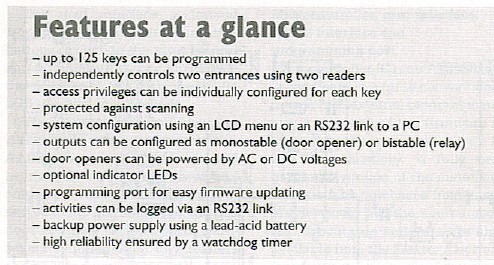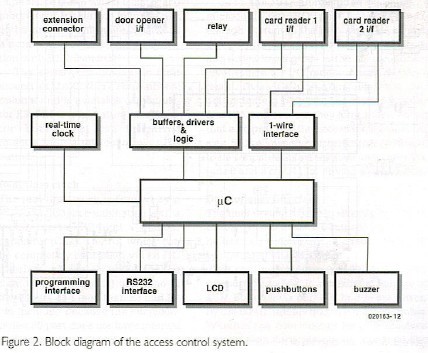

Project Solutions
iAccess--an intelligent access control system (1)
Published:2011/7/27 22:39:00 Author:Li xiao na From:SeekIC
Design by I. Joostens
Surveys show that people are feeling increasingly less safe. Consequently, protecting property and buildings receives more and more attention these days. One of the aspects of such protection is access control. The system described here goes further than most such systems. Besides granting persons selective access to specific areas, iAccess allows you to check who was granted access to which area and when. 
Nowadays, access control systems are available from quite a few manufacturers. These are usually either quite elaborate systems designed for thousands of users and offering a large number of features, or very limited models that are more suitable for private use. 
Most commercially available systems use electronic keys, such as magnetic cards, badges, iButtons, or transponders. There are also models that use PIN codes and/or biometric features.
The circuit described in this article combines the versatility and features of the large systems with the simplicity and ease of use of the small, stand-alone types. Here iButtons are used as electronic keys. Relative to other key systems, iButtons offer quite a few advantages, such as ready availability, a high level of robustness, and the fact that the user interface (reader) consists of only a simple set of contacts. Figure 1 shows a photo of an iButton with its associated read probe. 
Two entrances are independently monitored. The circuit includes a driver for a door opener as well as a relay output. The latter is suitable for enabling or disabling an alarm system, among other things. An optional link to a computer can be used to configure the system and record events in a log file.
Concept and block diagram 
The overall structure of the access control system is shown in Figure 2. As can be clearly seen, the key element is a microcontroller. It looks after reading the iButtons, handles communications via the RS232 interface and controls the peripheral components.
The microcontroller used here has 2 KB of EEPROM, which stores the physical key numbers (as engraved on the iButtons) and associated access privileges, as well as the system configuration parameters.
A special programming interface allows the microcontroller software to be easily updated. As the program uses a fairly large number of interrupts, it was not possible to have the microcontroller maintain the time of day using software. Consequently, a realtime-clock IC is used for this purpose.
The user interface is formed around an LCD module, four pushbuttons (including the reset button) and a miniature buzzer. To reduce the number of I/O pens used, the LCD is driven in 4-bit mode.
The iButtons are read using an intentionally simple 1-wire interface. As the length of the 1-wire bus will be relatively short in most cases, and only one 1-wire device will be connected to the bus each time, the bus does not have to meet particularly severe requirements. Key readers can be fitted with status indicators using red and green LEDs.
The system can drive most types of door openers that are suitable for use with a 12-V supply voltage. A circuit specially developed for this purpose allows the door opener to be driven using an AC or DC voltage as desired. To prevent possible damage to the access control system or the door opener in case of improper use or fault conditions, several supplementary protective measures have been incorporated.
As already mentioned, besides the door opener driver circuit there is also a relay output that can be used for additional switching functions. Finally, an expansion connector has been added for users who wish to experiment with the circuit.
Power for the entire circuit is provided by a lead-acid storage battery that is continuously recharged by a mains power supply. This provides two significant benefits. First, in case of a power outage the system will continue to operate from the battery for an extended length of time, so access to an area or building remains assured. Besides this, using a storage battery allows the mains power supply to be relatively modest in size, since the short current pulses needed to operate the door opener are provided by the battery instead of the mains supply.
Reprinted Url Of This Article: http://www.seekic.com/blog/project_solutions/2011/07/27/iAccess__an_intelligent_access_control_system_(1).html
Print this Page | Comments | Reading(1369)
Article Categories
New published articles
· Imagination works with TSMC to develop FinFET process
Author:Ecco Reading(33527)
· XMOS pushes event-driven MCUs with lower price
Author:Ecco Reading(3534)
· Intel brings upgraded 32-nm SoC for smartphones
Author:Ecco Reading(3250)
· Micron pushes TLC 128-Gbit NAND flash
Author:Ecco Reading(3816)
· Intel will stop supplying desktop motherboards
Author:Ecco Reading(5341)
· Processor market was expected to regain strength in 2013
Author:Ecco Reading(3318)
· It was reported that TSMC sales fall steeply
Author:Ecco Reading(3474)
· Cisco, NXP work with auto wireless startup
Author:Ecco Reading(3620)
· Micron was impacted by manufacturing glitch
Author:Ecco Reading(4017)
· China can make 22-nm transistor by themselves
Author:Ecco Reading(3820)
· Chip market rebound is coming, according to survey
Author:Ecco Reading(3761)
· Sony, Toshiba will spend more on chips, iSuppli reports
Author:Ecco Reading(3790)
· Qualcomm becomes the 13th company to join NFC Forum board
Author:Ecco Reading(6105)
· TSMC increases building work for FinFET fab
Author:Ecco Reading(3778)
· TI plans to cut 1,700 jobs in OMAP shift
Author:Ecco Reading(4587)